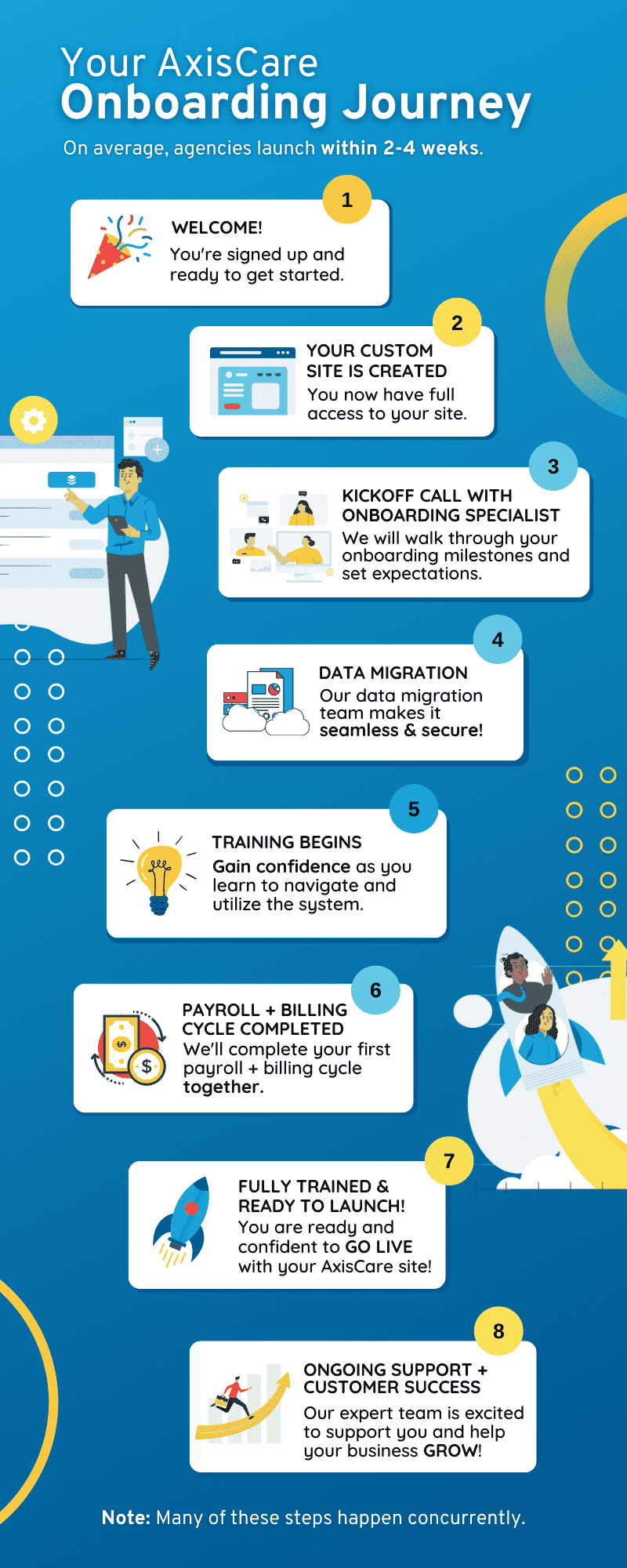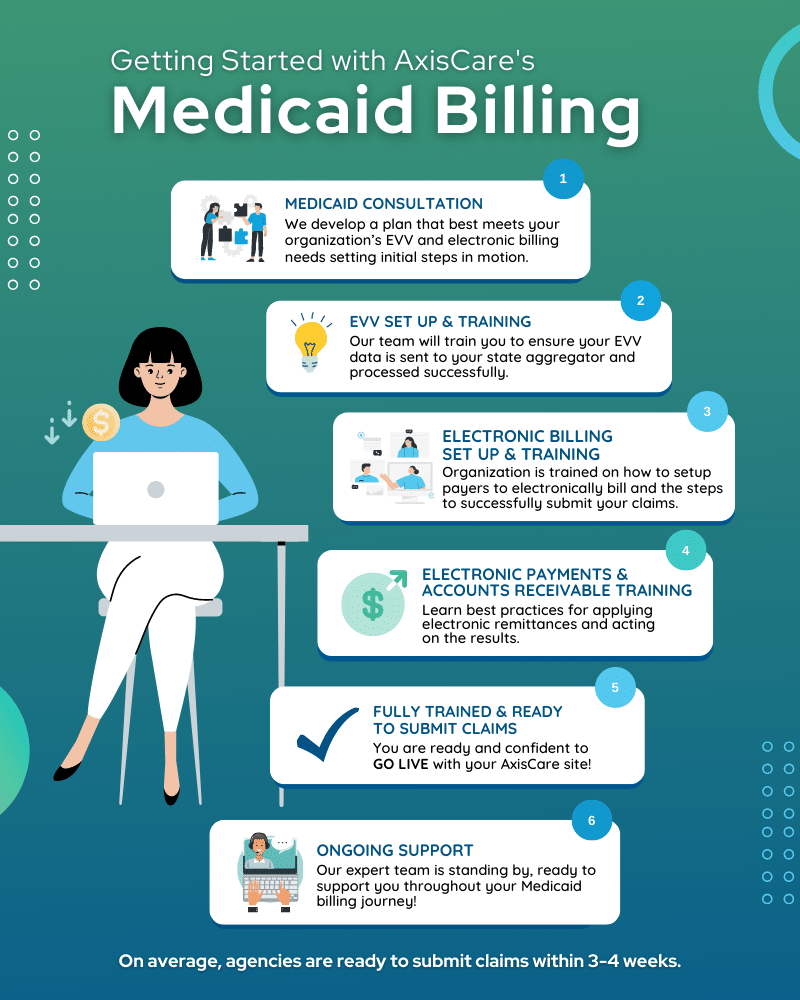In a home care context, patient collections refers to the process of getting paid by clients who have used your agency’s services.
While businesses that offer medical home care frequently deal with insurance companies and government agencies – which have well-defined billing systems and protocols in place – non-medical home care relies heavily on private pay clients. These clients may not understand the importance of prompt payment, are more prone to losing track of their invoices, and may even find themselves in over their heads as the cost of care piles up.
That means you’ll need a billing optimization plan in place to mitigate potential delays and efficiently deal with unpaid invoices. The financial health of your organization depends on it.
1. Implement Clear Upfront Financial Policies and Communication
From the outset of each client relationship, all parties should be on the same page about when and how payment should be rendered for the services provided. Your financial agreement will act as the foundational document that guides these processes, including:
- Service rates, billing cycles, and payment due dates. Specify if you expect payment in advance of service delivery or following the receipt of an invoice.
- Which payment methods you accept (i.e. credit, money transfer, check). Remember that a broader range of methods will likely increase the likelihood of receiving on-time payments.
- Late fees, interest charges, and potential care interruptions in the event of non-payment. Making clients aware of these consequences upfront will encourage them to pay on time.
- The dispute resolution process includes addressing billing concerns with your agency and how quickly clients can expect their issues to be addressed and resolved.
Following the initial consultation, provide a copy of these terms via email or printout and make sure all parties have provided a signature to acknowledge its validity.
2. Offer Multiple Convenient Payment Options
Different clients will have their own preferred payment methods. Offering a range of options will allow them to interface with whichever method feels most comfortable. No matter their selection, you’ll need a way to organize disparate payment records under one roof.
Online payment processing portals create a simple link between agencies and clients, allowing them to securely submit payments directly and feed directly into a reporting system. Debit and credit cards can also be processed online, often through a similar type of portal connected to a home care software platform. Automated payment plans receive money via ACH transfers or card auto-charges, requiring little involvement from clients following the initial setup.
Integrating With Payment Processing Systems
A unified system will significantly streamline collections and reduce admin work. Instead of juggling multiple platforms and paper trails, centralization also enables more transparent tracking and reporting.
First, research various home care platforms and select one that can accommodate a variety of payment options: credit cards, debit cards, and ACH transfers, at a minimum. If you already have home care management software in place, make sure your pick can integrate with your existing tech stack.
Next, automated billing and invoicing can be enabled to accept recurring payments and reduce manual follow-ups easily. Sending automatic reminders (i.e. a few days before a bill is due) can help clients remain on time.
Benefits of Automated Payment Plans
Life can get busy, and clients can be forgetful. If you collect payments automatically, none of that matters. Debiting clients directly eliminates the need for manual input, taking the onus off each individual and dropping funds straight into your account. This system also adds predictability to your cash flows with steady and reliable payments.
On the administrative side of things, automated plans lighten in-office employees’ workloads by reducing the need to follow up on delinquent payments.
3. Leverage Technology for Streamlined Billing and Collections
Home care software with integrated Electronic Visit Verification (EVV) is the easiest way to automate the billing process. Caregivers log their visits through an app using EVV, then the software links that information directly to an invoice. As soon as a visit is complete, the invoice is sent off.
As the payment due date draws closer, your home care software can send automated updates, prompting clients to settle on time and reducing the need for manual outreach. Reporting tools can track outstanding balances and payment trends both in real-time and on a longer time scale, helping agencies proactively address issues.
4. Train Staff on Effective and Compliant Collection Practices
The collections process should follow strict protocols that keep things ethical, effective, and legally within bounds. Staff should be aware of how to communicate appropriately about payment-related matters, ensuring they approach conversations with empathy while staying true to agency policies.
For example, the Fair Debt Collection Practices Act (FDCPA) establishes guidelines to protect client privacy and avoid aggressive collection tactics. Staying current on the latest rules regarding Medicaid and private pay collections will keep related conversations relevant, above board, and free from any risk of legal recourse.
5. Monitor Key Performance Indicators (KPIs) and Continuously Improve
Tracking patient collection trends helps agencies identify weak points in their billing processes. Metrics like Days Sales Outstanding (DSO) measure how long it takes to collect payments, and collection rates reveal how many invoices have been settled. Aging accounts receivable (A/R) monitors overdue balances, pushing agencies into action before they become uncollectible.
Home care software can execute all of these data collection and analysis processes. It generates reports in real-time that reveal operational trends and late payers, allowing you to adjust your collection strategies accordingly and reach out to higher-risk accounts. These insights hold the key to a more optimized billing process, an ever-shrinking amount of outstanding balances, and a more stable financial picture overall.
Optimize Patient Collections for Home Care With AxisCare
Stop chasing unpaid invoices and let home care software do the heavy lifting. With AxisCare, you can automate the entire billing process, from seamlessly creating invoices based on EVV data to passively following up and understanding where to focus your collections efforts. Reach out to our team for a personalized demo!









